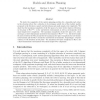Free Online Productivity Tools
i2Speak
i2Symbol
i2OCR
iTex2Img
iWeb2Print
iWeb2Shot
i2Type
iPdf2Split
iPdf2Merge
i2Bopomofo
i2Arabic
i2Style
i2Image
i2PDF
iLatex2Rtf
Sci2ools
SWAT
1998
Springer
1998
Springer
Models and Motion Planning
We study the complexity of the motion planning problem for a bounded-reach robot in the situation where the n obstacles in its workspace satisfy two of the realistic models proposed in the literature, namely unclutteredness and small simple-cover complexity. We show that the maximum complexity of the free space of a robot with f degrees of freedom in the plane is (nf/2 + n) for uncluttered environments as well as environments with small simple-cover complexity. The maximum complexity of the free space of a robot moving in a three-dimensional uncluttered environment is (n2f/3 +n). All these bounds fit nicely between the (n) bound for the maximum free-space complexity for low-density environments and the (nf ) bound for unrestricted environments. Surprisingly--because contrary to the situation in the plane--the maximum free-space complexity is (nf ) for a three-dimensional environment with small simple-cover complexity.
Algorithms | Maximum Complexity | Maximum Free-space Complexity | Small Simple-cover Complexity | SWAT 1998 |
| Added | 06 Aug 2010 |
| Updated | 06 Aug 2010 |
| Type | Conference |
| Year | 1998 |
| Where | SWAT |
| Authors | Mark de Berg, Matthew J. Katz, Mark H. Overmars, A. Frank van der Stappen, Jules Vleugels |
Comments (0)

